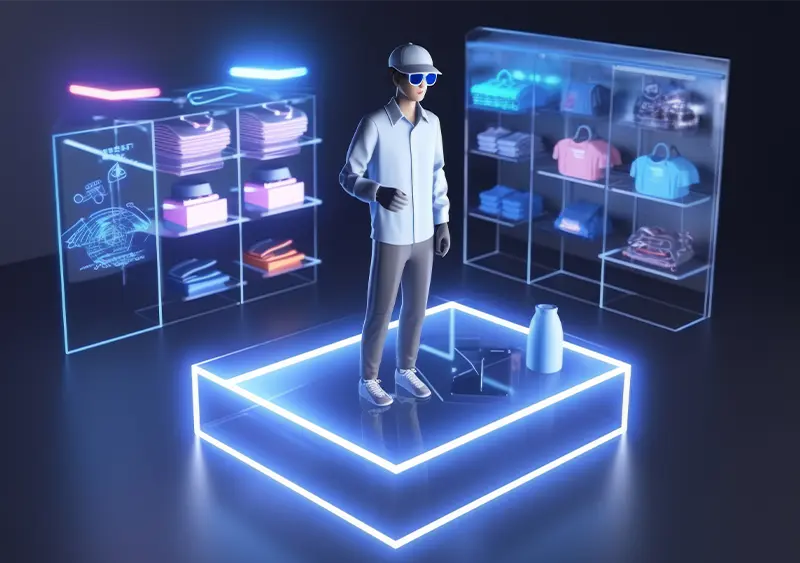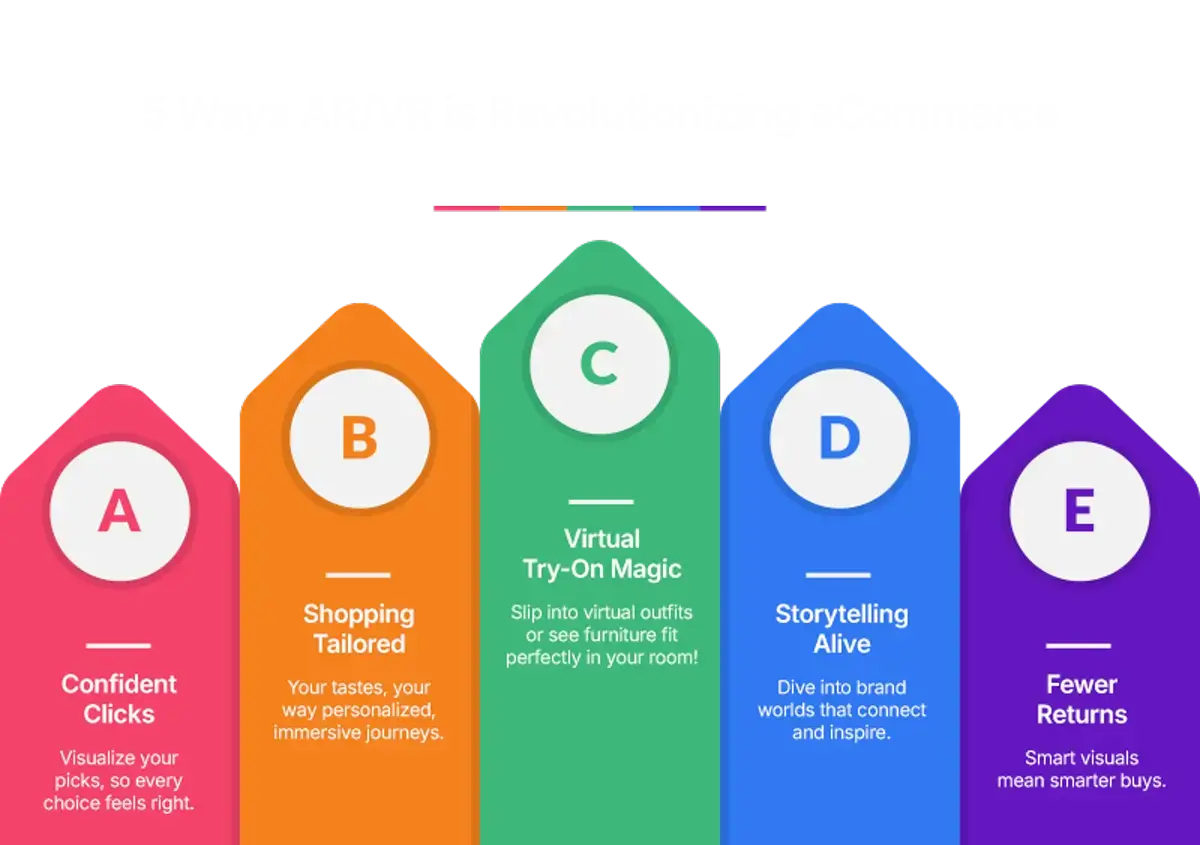How AR/VR is Shaping eCommerce Experiences
You don’t need to imagine what something will look like anymore! AR/VR shows you.

5 MIN READ
Published November 08, 2024

Written By
Rahimudeen M
Imagine trying on clothes virtually or placing furniture in your living room without ever leaving home. With AR (Augmented Reality) and VR (Virtual Reality), this isn’t just futuristic thinking, it’s happening NOW.
Augmented and virtual reality are reshaping how we shop, offering experiences that go beyond just clicking “add to cart.” Now, it’s about interacting with products in ways that feel real, personal, and exciting.
Keen to learn how it’s all happening? Let’s find out!
What is AR in eCommerce?
Now, we’ll get into what AR in eCommerce actually means. Augmented Reality, or AR, brings digital elements into your real world. For online shopping, it’s like giving your customers a chance to “try before they buy,” but without ever leaving their homes.
Let’s say, you’re shopping for a new pair of sunglasses, and with AR, you can see exactly how they’ll look on your face. Or maybe you’re trying to find the perfect coffee table, and AR lets you place it in your living room to check the size and style. No more guessing, just a clear view of how products fit into your life.
For businesses, AR means fewer returns, happier customers, and a better shopping experience overall.
And that’s just the start, let’s take a look at how VR shopping is shaking things up too.
What is Shopping in VR?
Virtual Reality, or VR, takes things a step further by immersing you in a completely digital world. Consider stepping into a virtual store, where you can browse the aisles, pick up products, and explore items just like in a physical shop, but from the comfort of your home.
Think of it as putting on a headset and being transported to a virtual mall. You can walk around, interact with products, and even chat with virtual assistants who help you find what you need. It’s a game-changer for online shopping, offering a unique experience that goes beyond the traditional eCommerce platforms.
For brands, this means creating an engaging, memorable shopping experience that keeps customers coming back for more.
5 Core Benefits of AR/VR in eCommerce
Now that we’ve explored what AR and VR are, let’s dive into how these technologies are transforming the way we shop. Here are some of the standout benefits.
Elevate your eCommerce business using AR/VR. Partner with Asia's largest 3D design studio for innovative solutions.

-
1. Try Before You Buy, Virtually
Shopping online always comes with that nagging question: “Will this really look good on me?” With AR, you can virtually try on clothes, see how furniture fits in your living room, or even test makeup. VR takes it up a notch by giving you a full virtual store experience — browse, select, and even visualize products in real-time before buying.
-
2. Boosting Customer Confidence
Dream up buying something and knowing exactly how it fits or looks before it arrives. AR/VR tools give shoppers the confidence they need to make decisions without hesitation. By visualizing products in their environment or on themselves, customers are less likely to be surprised when the product arrives at their doorstep.
-
3. Creating Personalized Shopping Journeys
Gone are the days of one-size-fits-all shopping experiences. AR and VR allow for highly personalized experiences tailored to individual preferences. Virtual stores can now adjust product recommendations based on your tastes, showing you what you actually want to see.
-
4. Fewer Returns, Fewer Headaches
With more accurate visualizations of products, shoppers make better-informed choices, leading to fewer returns. This isn’t just great for the customer. It’s a huge win for retailers, cutting down on costs and improving customer satisfaction.
-
5. Immersive Brand Experiences
AR and VR let brands tell stories like never before. From immersive virtual tours to interactive product demos, these technologies allow customers to dive deep into a brand’s world. This kind of engagement builds loyalty and leaves a lasting impression.
Sound’s exciting isn’t it? Next up, let’s see how AR/VR is being used in the real world to reshape eCommerce experiences.
How AR and VR Boost Customer Confidence
It’s no secret that uncertainty can hold customers back from making a purchase. But what if you could erase that doubt? That’s where AR and VR come in, giving shoppers the confidence to hit “buy” without second-guessing themselves.
-
Seeing is Believing
One of the biggest advantages of AR is letting customers see products in their real-world environment. From placing a virtual couch in your living room to testing how a pair of shoes look on your feet, AR eliminates the “what ifs.”
This visual assurance makes customers feel more confident in their choices because they know exactly what they’re getting.
-
Interactive Shopping Without Leaving Home
For some, the idea of walking through a store virtually like browsing shelves, picking up items, and even trying on clothes, may have once seemed futuristic. But VR is making this a reality.
Shoppers can explore virtual stores as if they were there in person, making decisions based on more than just flat images and descriptions. This interactive shopping boosts confidence because customers feel more involved in the buying process.
-
Reducing Buyer’s Remorse
Have you ever bought something online, only to feel disappointed when it arrives? AR and VR aim to reduce that by giving customers a more accurate experience before they commit.
They can examine products from every angle, ensuring the item meets their expectations, which ultimately cuts down on returns and dissatisfaction.
-
More Control, Fewer Surprises
AR/VR doesn’t just create a more engaging experience. It also empowers customers to make decisions with more control. They’re no longer relying on just product descriptions or reviews, they’re engaging with the product in a way that gives them complete certainty.
Real-World Examples of AR/VR in eCommerce
Let’s take a look at some real-world examples that show how AR and VR are changing the way we shop.
-
IKEA: Visualize Furniture in Your Space
- IKEA’s Place app uses AR to let customers see exactly how a piece of furniture would look and fit in their home.
- Just point your phone, select a product, and place it virtually in any room.
- It removes the guesswork and helps customers feel confident about their purchase, turning a traditionally bulky shopping experience into something fun and easy.
-
Sephora: Try Makeup Before You Buy
- Trying makeup online can be tricky, but Sephora solves this with their Virtual Artist feature.
- Customers can use AR to see how different products look on their face before they buy.
- From lipstick to eyeshadow, this tool personalizes the shopping experience and helps customers make informed decisions, reducing the chances of returns.
-
Nike: Find Your Perfect Fit
- Nike took the challenge of finding the right shoe size online and made it simple with AR.
- Using their app, customers can scan their feet to get the perfect size recommendation for different shoes.
- This eliminates sizing uncertainty, which is a common issue in online shoe shopping, and boosts customer satisfaction.
-
Alibaba: Virtual Reality Shopping
- Alibaba has pushed the boundaries of eCommerce with their BUY+ VR experience.
- Shoppers can explore virtual stores, interact with products, and make purchases all in a virtual environment.
- It blends the convenience of online shopping with the immersive feel of browsing in a physical store, offering a glimpse into the future of retail.
-
Warby Parker: Try Glasses from Home
- Buying glasses online just got easier thanks to Warby Parker’s AR-powered try-on tool.
- Customers can see how different frames look on their face from every angle, helping them pick the perfect pair without needing to visit a store.
- It mimics the in-store experience and allows for a more comfortable, confident shopping process.
These brands are leading the way in AR and VR adoption, showing how these technologies can make online shopping more engaging, interactive, and fun. But what does this mean for the future?
Challenges and Limitations of AR and VR in eCommerce
As exciting as the technology is, it comes with a few hurdles that businesses need to consider before jumping in.
- ⛔ High Development Costs: Developing AR/VR experiences requires significant investment, making it a tough decision for smaller businesses with limited budgets.
- ⛔ Accessibility and Device Compatibility: Not all shoppers have the necessary devices for AR or VR, especially when it comes to VR headsets, limiting the reach of these experiences.
- ⛔ Learning Curve for Consumers: Some consumers may find AR and VR tools confusing, which could slow down their shopping experience or lead to frustration.
- ⛔ Potential Technical Glitches: Bugs, slow loading times, and connectivity issues can ruin a customer’s experience, driving them away from the technology.
- ⛔ Privacy and Data Security Concerns: Collecting personal and spatial data raises concerns about how securely this information is handled, which could deter customers from using these technologies.
The Future of AR/VR in eCommerce
The future of AR and VR in eCommerce looks incredibly promising as these technologies continue to evolve.
- AR and VR will merge with daily online shopping, allowing users to try on products virtually with perfect accuracy.
- Shopping experiences will become more personalized, with custom virtual store layouts and product recommendations.
- AR and VR will become standard features on most eCommerce platforms, with virtual showrooms becoming the norm.
- AI will enhance AR/VR experiences, offering smarter product recommendations and interactive virtual assistants.
- Expect more AR shopping events and virtual influencers driving purchases directly through immersive experiences.
Final Thoughts: Why AR/VR is the Future of eCommerce
AR and VR are making that possible, letting customers try before they buy, interact with products, and make confident decisions from the comfort of their home. It’s not just a trend, it’s the next step in how we shop online.
As AR/VR technology keeps evolving, it’s going to change the game for eCommerce, blending convenience with immersive experiences. Ready to take your online store to the next level? The future of shopping is here — don’t miss out.
About the writer :
Rahimudeen M is the Senior Operations Manager at Zealous Services, with over 17 years of experience in project management and client success. He ensures smooth operations across 3D visualization, animation, and modeling projects. ... A natural leader, Rahimudeen is passionate about building high-performing teams and delivering top-tier results for clients across global markets.
Read More